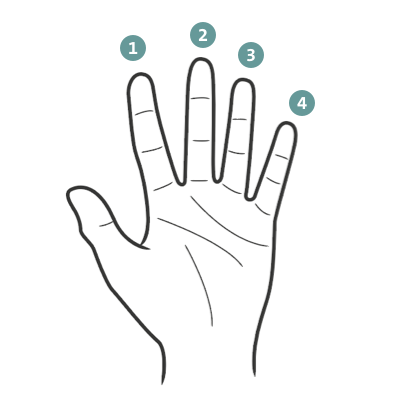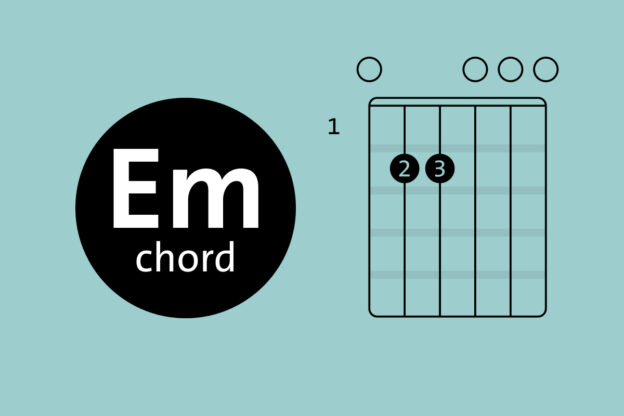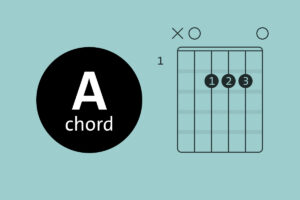You’ve been dreaming of a career in rock ‘n’ roll for a long time, but there are two little problems: you don’t have a guitar and, even if you had, you don’t know how to use it. The first problem can be solved with a summer job and a letter to Santa. The second is more challenging. That’s where we come in. Chordify helps you step by step and starts with the basics: the Em chord.
Estimated reading time: 7 minutes
In this article about the Em chord you’ll find
How to play an Em chord?
So, how do we play an Em (E minor) chord? You always start by tuning your guitar, like we explained in the blog post about the basic E chord. Then you have a look the chord diagram and you get your fingers in the right position on the fretboard. So let’s start with step one.
Step 1 – Tune your guitar to E
Playing guitar is a centuries-old craft. And throughout history musicians have experimented with different ways of tuning their instruments.
How about an open D tuning, which is frequently used in metal. Or an Eb tuning, popular in grunge and rock. Those are cool but not relevant for the lesson at hand. So, let’s start at the beginning. Tuning your guitar to E. Check out our blog post with tips & tricks for tuning your guitar. You can use an analog or digital tuner, or a tuning app like KARANG.
Step 2 – Study the Em chord diagram
The standard representation for a chord shape is a chord diagram (shown below). This is a picture that shows the position of your fingers on the fretboard. Take a good look at the picture below. What do you notice?
There are four circles lining the top; a number 1 at the top left-hand corner; and in the grid there are two black dots, each with a number. What you’re looking at is an abstract representation of a part of the neck of the guitar. “But which part?” Good question! The “1” in the top left-hand corner helps you get your bearings. It indicates the fret, in this case the first, where you will put you fingers.
The light-grey horizontal lines all represent frets. The black vertical lines are strings. From left to right you see: the low E, the A, the D, the G, the B and the high e. The black dots on the strings indicate the position of your fingers. The 2 is your middle finger and the 3 is your ring finger. The circles at the top tell you that these strings are played “open.” This means you play them without placing your fingers anywhere on the fretboard.
Step 3 – Play the Em
Now you know how to read a chord diagram. Simple, isn’t it? Put your middle finger on the second fret of the A string and your ring finger on the second fret of the D string. Note: an Em chord can also be played with your index and middle finger, or even your ring finger and pinky. This depends on your preference or which chord you want to play afterwards.

Now press down on the strings with your finger tips; and apply some pressure. Does it hurt? You’ll get used to it. The life of a rocker isn’t always easy. When pressing the strings, make sure you’re not touching any other strings by accident. All strings should be free to resonate and produce a clear tone. Strike them all now. And? Sounds good, doesn’t it? Congratulations! Now you know how to play an Em.
Some bonus steps to get the most out of the Em chord
Now you can ask: “Alright, we managed to place the left hand on the fretboard. But which strings should we pluck or strum with the right hand?” It’s a very good and important question, rising rock star! Even a properly placed chord in the left hand can sound terrible if the right hand plays the wrong strings.
Below we will give you two examples of the most common ways to play a chord – strumming and arpeggios. Simply put, strumming is usually used in more dynamic songs, while arpeggios are for more lyrical songs.
Arpeggio
In short, an arpeggio is the way of playing notes from the chord one after another. And when playing a chord, it’s important to start with the string which has a tonic note of the chord – this is called the root note. Usually this note is located on the bass strings. It’s easy to determine the root note, because it has the same letter as the chord name.
For instance, Em has a root E, and E major has a root E. Guess what the root of an A chord is? Right, it’s the A note. Quite handy, right? In the case of the Em chord, the root note is the open sixth string, which is E. So, we will start with that string. After that we’ll play the upper three strings: 3rd, 2nd and 1st.
So, we’ll play these four strings in sequence: 6th, 3rd, 2nd and 1st. Below you can see what it looks like in the note charts:
Funnily enough, for this chord we only press two frets on the strings with the left hand, and in this exercise we’re leaving them out. Don’t worry, we’ll play all the strings later for the strumming exercise.
We’ve also Chordified this video for you, so you can jam along and play an Em chord with us.
Strumming
This is probably one of the most commonly associated playing techniques with the guitar. Now we’ll learn how to play a strumming pattern for the Em chord. The good news is that you can strum over all six strings. But, as with an arpeggio, we should start with the root note, which is the 6th open string.
The Em chord is a great example of a chord where you strum over all six strings and most of them are open. In this exercise we will alternately play downstrokes and upstrokes – “downstroke” means from the 6th (thickest) string to the 1st string, and “upstroke” means the other way around. On the chart below we indicate it with arrows.
We’ve Chordified this video for you, so you can jam along and play an Em chord with us.
Enough theory for now! Get out your guitar and start jamming. Here’s a list of songs in Em. Finding it hard to stay motivated? Read this blog post about motivating yourself. Do your fingers hurt? Check out these five tips to prevent this.
Enjoy and happy jamming!






